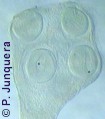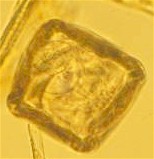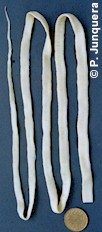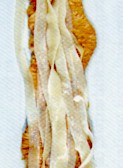Moniezia is a genus of parasitic tapeworms that has cattle, sheep, goats and other domestic and wild ruminants as final hosts. There is one report on Moniezia tapeworms found in pigs.
The most important species are
- Moniezia expansa (the sheep tapeworm, the double-pored ruminant tapeworm; more frequent in sheep and goats)
- Moniezia benedeni (more frequent in cattle).
There are some related species (e.g. Avitellina centripunctata,Thysaniezia ovilla) that are not pathogenic and very difficult to distinguish from Moniezia through analysis of fecal samples.

Moniezia tapeworms are found worldwide, with a variable incidence. In endemic regions more than 50% of the herds may be infected.
Ther disease caused by Moniezia spp is called monieziais.
Moniezia tapeworms do not affect dogs, cats, horses, swine or poultry.
Is livestock infected with Moniezia tapeworms contagious for humans?
NO. The reason is that Moniezia tapeworms are not human parasites (there is one single report on a case of human infection in Egypt). See the life cycle below.
You can find additional information in this site on the general biology of parasitic worms and/or tapeworms.
Final location of Moniezia spp
The predilection site of adult Moniezia tapeworms in their final hosts (sheep, goats, cattle, etc.) is the small intestine.
Anatomy of Moniezia spp

Adult Moniezia worms belong to the largest parasitic worms of livestock. They can reach up to 10 m in length. Moniezia expansa can be up to 1.5 cm wide, Moniezia benedeni up to 2,5 cm. The head (scolex) measures about 0.8 cm and has 4 prominent suckers but no hooks.
The main body (or strobila) has hundreds and up to thousands of segments (called proglottids). The segments are much broader than long. As in all tapeworms, each segment has its own reproductive organs of both sexes (i.e. they are hermaphroditic) and excretory cells known as flame cells (protonephridia). The reproductive organs in each segment have a common opening called the genital pore. In young segments all these organs are still rudimentary. They develop progressively, which increases the size of the segment as it is pushed towards the tail.
Mature gravid segments are full of eggs (several thousands) and detach from the strobila (i.e. the chain of segments) to be shed outside the host with its feces. Otherwise, as other tapeworms, they have neither a digestive tube, nor a circulatory or respiratory systems. They don't need them because each segment absorbs what it needs directly through its tegument. Individual gravid segments in the feces are visible by the naked eye.
The eggs have a thick envelope. Those of Moniezia expansa have a triangular shape and measure ~55 x 65 micrometers, those of Moniezia benedeni are cube-shaped and measure about 80 micrometers.
Life cycle and biology of Moniezia spp

As all tapeworms, Moniezia spp has an indirect life cycle with ruminants (sheep, goats, cattle, etc,) as final hosts, and oribatid mites (also called "moss mites" and "beetle mites") as intermediate hosts.
The adults of some Moniezia species lay eggs already in the intestine of their final hosts that are shed with the feces. In other species the gravid segments containing the eggs are shed out and release the eggs only outside the host. The eggs are sticky and adhere to the vegetation or soil particles. Depending on the species and the region they can survive for months in the environment and some may survive cold winters, but they are very sensitive to dessication.
The oribatid mites ingest the eggs, which hatch in their gut and develop to cysticercoids in the body cavity of the mites. They are infective for the final hosts. Cysticercoids can survive for months inside the mites, which on their turn have a live span of up to 18 months.
The final host becomes infected after ingesting contaminated mites while grazing. The mites are digested and release the cysticercoids that attach to the gut's wall and develop to adult tapeworms within a several weeks, depending on the worm species and the final host. The adult worms live for up to 18 months inside their final host.
Harm caused by Moniezia spp, symptoms and diagnosis
Moniezia infections are rather benign for adult livestock and usually do not cause clinical signs. Nevertheless, they compete for nutrients with the host and their presence can negatively affect productivity. Lambs are more susceptible and massive infections can cause diarrhea, reduced weight gain and intestinal obstruction. However, many studies have failed to show an economic impact of Moniezia tapeworms on sheep productivity.
It must be also considered that sheep, goats and cattle are often infected not only with tapeworms, but also and mainly with gastrointestinal roundworms, which are substantially more harmful than tapeworms. In this typical situation it is difficult to determine whether tapeworms significantly worsen the harm due to roundworms or not. >
Diagnosis is based on fecal examination for the presence of gravid segments (proglottids) or of eggs with a characteristic morphology. After necropsy the large tapeworms are easily seen inside the gut.
Prevention and control of Moniezia infections

It is not possible to eliminate the oribatid mites in the pastures. The use of insecticides for this purpose is not advisable, because it is more expensive than the potential economic loss due to the infections, and because it detrimental effect on the environment: it would kill not only the oribatid mites, but numerous beneficial insects as well.
In endemic zones with high incidence it is recommended to harvest the hay, to deeply plow the fields (the mites tend to burrow deeply in the soil) and to reseed them. This can reduce the mite population. Nevertheless, some mites will survive in the unplowed borders and will re-infect the pastures in a few years.
Since the mites prefer humid pastures and avoid light as well as dryness, they are more active early in the morning and at nightfall. This can be considered for deciding where and when to bring susceptible livestock for grazing./p>
Susceptible livestock, particularly lambs can be treated with anthelmintics effective against tapeworms. They contain either broad-spectrum active ingredients (e.g. albendazole, fenbendazole, mebendazole, oxfendazole, etc.) or specific taenicides (e.g.,> niclosamide, praziquantel, etc.). Specific taenicides are also used in mixtures with nematicides (e.g. ivermectin, levamisole, etc.).
These active ingredients are mainly available as drenches. A few ones are also available as slow-release boluses, injectables, feed additives or tablets, but not everywhere.
Excepting slow-release boluses, most wormers kill the worms shortly after treatment and are metabolized and/or excreted within a few hours or days. This means that they have a short residual effect, or no residual effect at all. As a consequence treated animals are cured from worms but do not remain protected against new infections. To ensure that they remain worm-free the animals have to be dewormed periodically, depending on the local epidemiological, ecological and climatic conditions.
Other classic livestock anthelmintics such as macrocyclic lactones (e.g. ivermectin, doramectin, moxidectin, etc.), levamisole, tetrahydropyrimidines (e.g. pyrantel, morantel) and piperazine derivatives are not effective at all against Moniezia or whatever tapeworm.
There are so far no vaccines against Moniezia tapeworms. To learn more about vaccines against parasites of livestock and pets click here
Biological control of Moniezia tapeworms (i.e. using its natural enemies) is so far not feasible.
You may be interested in an article in this site onmedicinal plants against external and internal parasites.
Resistance of Moniezia tapeworms to anthelmintics
So far there are only very few reports on resistance of Moniezia tapeworms to benzimidazoles (e.g. fenbendazole) and it is certainly not yet a widespread problem.
This means that if an anthelmintic fails to achieve the expected efficacy, chance is very high that either the product was unsuited for the control of Moniezia tapeworms, or it was used incorrectly.
|
Ask your veterinary doctor! If available, follow more specific national or regional recommendations for Moniezia control. |